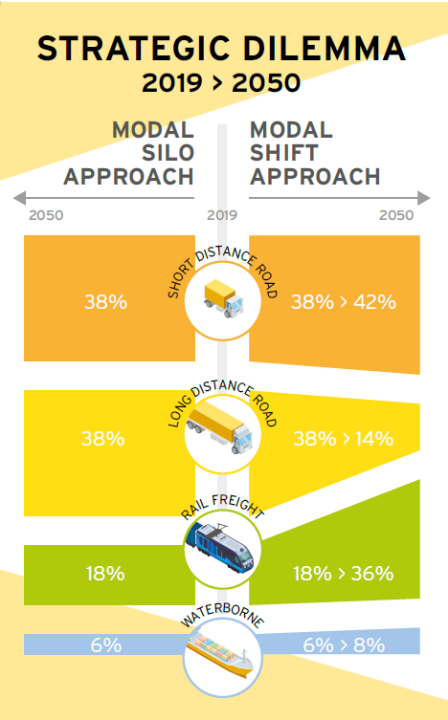EU policy objectives and European law
The European Union Member States decided to meet their COP-16 obligations by turning Europe carbon-neutral by 2050. The European Green Deal of 2019 contains this objective together with an interim milestone of 55% greenhouse-gas emission cuts to be achieved by 2030.
The Fit for 55 Package of legislations together with the Greening Freight Package of June 2023 will establish the regulatory framework for the decarbonisation effort.
Pursuant to the energy crisis that started in the second half of 2021 and the Russian attack of Ukraine in February 2022 attention turned to substantially boosting the energy (and resource) efficiency of the European economy together with reducing its reliance on imported fossil fuels. These objectives were incorporated into the REpowerEU Initiative.
Transportation has been the sole sector of the economy, which instead of reducing its carbon intensity during the past decades, actually increased it. Energy efficiency of freight transportation has not advanced either and – with the exception of electric rail freight – the sector was powered largely by diesel and other mineral oil derivatives.
 The modal shift dilemma: The legislator faces a strategic dilemma when designing the approach to regulating transport with a view to deliver the desired policy objectives: whether to try to fix things within the individual modes of transport (assuming that there is no shift between them), or to approach the essence for the need to move around goods and allow the best solution to prevail – may it be one that actually combines several modes?
The modal shift dilemma: The legislator faces a strategic dilemma when designing the approach to regulating transport with a view to deliver the desired policy objectives: whether to try to fix things within the individual modes of transport (assuming that there is no shift between them), or to approach the essence for the need to move around goods and allow the best solution to prevail – may it be one that actually combines several modes?
Reduction of externalities: clean air, road accidents, noise, congestion, land use and biodiversity
The European Green Deal and the Fit for 55 package: decarbonisation should be achieved through a shift to electric rail freight, by the use of biofuels, as well as using hydrogen.
REPowerEU: energy efficiency has scarcely been addressed from a technology perspective. Solutions are proposed through the installation of protruding aerodynamic elements to trucks, using aerodynamic tractors, EMS trucks and organisational solutions reducing empty runs of trucks. Neither are capable to deliver the results Combined Transport can (40-70% pro-rata energy efficiency improvement compared to the road-only alternative run by a Euro6 truck).
Country- and region-specific objectives
Protection of the Alps: the Alpine Initiative strives to protect the unique and ecologically sensitive Alpine region and preserve it as a living space. As an independent Swiss environmental organization, we are ensuring the implementation of a sustainable transport policy and are committed to effective measures for climate protection : https://www.alpeninitiative.ch/en/
Similar regional, local environmental consciousness programmes exist and are forming throughout Europe.
Managing the risk from freight transport:
As a major exporting nation, the Netherlands transports a lot of freight by road and rail. The government works with regional authorities and companies to ensure that freight transport along important routes – via our coastal ports to Germany and Belgium, for example – proceeds as smoothly as possible : https://www.government.nl/topics/freight-transportation
Combined Transport’s capabilities
Performance and capabilities: A study produced in 2021 found that contemporary door-to-door Combined Transport uses 70% fewer kilowatt-hours to create a tonne-kilometre transport performance output compared to the currently dominant unimodal road haulage.
The road-legs, the intermodal transshipment terminals and the rail portions of the journey conducted on the increasingly electrified railway network can all be powered by locally generated carbon-free electricity. This means that the harmful emissions of door-to-door Combined Transport may be as much as 90% lower than the currently dominant unimodal road haulage.
Zero-carbon door-to-door Combined Transport was found to be the most viable and least risky way to decarbonise freight transport-chains, while – simultaneously – also minimising their harmful emissions such as pollutants PM2,5, PM10, NOx as well as noise. Battery electric powered trucks
Market share and capacity
50% of rail freight tonne-kilometres produced on the European railway network are attributable to intermodal rail freight. Together with the estimated road-leg distances the road-rail Combined Transport is responsible for about 10% of cargo movements in Europe (2023).
Potential
Port, terminal as well as rail infrastructure capacities would allow the increase of intermodal transport’s market share. Vast portion of the cargo carried in unimodal truck transport can be carried in intermodal as well. All those road based land transport movements, which take place in the more densely populated and/or intensive industrial areas of Europe today could be shifted to intermodal transport. On island-relations a marked volume-increase could only be achieved in case the opulation and/or the intensity of economic activities were to significantly expand. Overall, the roughly 1000 billion tonnekilometres of road hulage performance realised over distances of 300km or more in Europe (2023) offer ample opportunities for intermodal transport to grow.

Akos Ersek
Chief Policy Advisor


